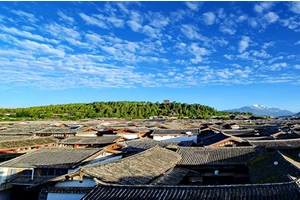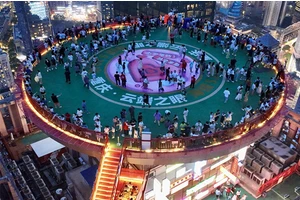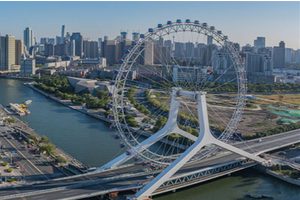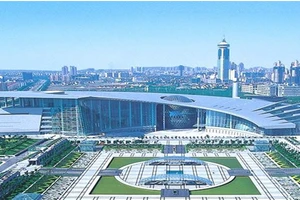Introduction of tourist attractions in Changsha, Hunan Province
Changsha, also known as Star City, is the capital of Hunan Province and one of the central cities in Central China. Changsha has a unique historical and cultural heritage, and it is a very attractive city, attracting countless tourists from home and abroad. So what are the interesting places in Changsha?
Here, let Beidou introduce you to the top ten must-see attractions in Changsha. I hope you will like them.
First, Yuelu Mountain
Yuelu Mountain was recorded in Nanyue Ji by Xu Lingqi during the Liu and Song Dynasties in the Southern and Northern Dynasties.
Eight hundred miles around Nanyue, headed by Hui Yan, the foot of Yuelu is enough.
Named after it. Yuelu Mountain is located on the west bank of Xiangjiang River and belongs to the branch of Hengshan Mountain in Nanyue. The ancients listed Yuelu Mountain as one of the 72 peaks in Nanyue Mountain, which is called Linglu Peak.
A Yuelu Mountain, Half the History of Changsha
Yuelu Mountain has always carried the love and pride of Changsha people, and it is also the root of Huxiang culture. In ancient times, Yuelu Academy, which was founded in the Northern Song Dynasty, is one of the four famous ancient academies in China and the largest and best preserved ancient academy in China. Nowadays, Central South University, Hunan University, Hunan Normal University and other institutions of higher learning have gathered at the foot of the mountain, and how many people of insight have been trained for Sanxiang.
There are many places of interest in Yuelu Mountain, including Yuelu Academy, Aiwan Pavilion, Lushan Temple, Yunlu Palace, Yuwang Monument, etc., and there is also the oldest and most valuable Lushan Temple Monument in Changsha. The inscription describes the establishment and development of Lushan Temple from the time when the temple was built in Jintai to the Tang Dynasty.
Stop and sit in the maple grove late, and the frost leaves are red in February flowers.
Du Mu's "A Journey to the Mountain" is very straightforward and thorough. It has been circulated for thousands of years, and it has achieved the Love Night Pavilion and Yuelu Mountain. Scenery is expressed in words, and words are named after scenery. Love Evening Pavilion is the business card of Yuelu Mountain, and it is also the most beautiful scenic spot. It is also known as Zuiweng Pavilion in Chuzhou, Huxin Pavilion in Hangzhou and Taoran Pavilion in Beijing.
Four famous pavilions in China
.
All the year round, Yuelu Mountain is beautiful, and in spring, new buds are green and flowers are fragrant. Summer is full of foliage and trees; In autumn, the mountains are red and the layers of forests are dyed; Winter is covered with white snow. Qian Fan has been exhausted and washed away, and Yuelu Mountain has always stood by the Xiangjiang River, guarding the development and changes of the city.
Address: No.58 Denggao Road, Changsha
Second, orange island
Orange Island, formerly known as Shuiluzhou and Long Island, is located in the middle reaches of Xiangjiang River. It is named after Mao Zedong's "Qinyuan Chunchangsha" and is known as.
China No.1 Zhou
. Orange Island is rich in beautiful oranges, so it is named.
Jiang Tian mu Xue
It is one of the eight scenic spots in Xiaoxiang.
Orange Island looks at Yuelu Mountain in the west, Changsha City in the east and surrounded by water. It is a long and narrow island. The island has beautiful natural landscape and rich places of interest, including Chairman Mao's youth art sculpture, Arch Tower, Zhenjiang Pavilion, Orange Island Park, Folk Culture Park and many other scenic spots, which can be described as beautiful and beautiful.
Among them, the most prominent is the Mao Zedong Youth Art Sculpture, which is 32 meters high, 83 meters long, 41 meters wide and has a pedestal of 3,500 square meters. It is the largest single landscape in orange island and can be seen from a distance. The whole sculpture is exquisitely designed and exquisitely crafted, which highlights the image of young Mao Zedong in his prime, with bright eyes, full of vigor and hope.
Another eye-catching thing is the Gongji Building at the northern end of Orange Island, which is the best scenic spot. Because of the beautiful scenery, many literati in the past dynasties have been attracted to visit the building and recite poems. The Gongji Building, which faces south, has a unique shape. It has five floors, including the main building, the Lushan Mountain in sight, the Taohuixuan, and the Meiting Pavilion. It is a good place to climb and pray.
Next to the Gongji Building, there are ancient garden buildings such as Miaoqian Street and Jiangshen Temple, rockery bonsai, pavilions and pavilions, small bridges and flowing water, towering ancient trees, as if walking into a cool water town in the south of the Yangtze River.
Address: No.2 orange island, Yuelu District, Changsha
Third, Martyrs Park
Hunan Martyrs Park, the largest comprehensive park in Changsha, consists of a memorial area and a tourist area. It is divided into six major areas: Martyrs Memorial Park, People's Leisure Park, Waters Scenery Park, Folk Custom Park, Children's Amusement Park and Landscape Leisure Park.
There are mountains and water in the park, rich in green plants, and it is known as Changsha City.
green lung
And there are Hunan Martyrs Memorial Tower, Nianjiahu, Yingfeng Bridge, Memorial Pavilion Gallery, Xianxian Pavilion, Arc Pier, Qijiawan, Tengqiao, Hongjundu and other scenic spots.
The Martyrs Memorial Tower is made of white marble and granite, with a monument inscribed with Mao Zedong's autograph on it, and a memorial hall below, which displays the portraits and life stories of more than 90 martyrs such as Xia Minghan, Guo Liang and Yang Kaihui, as well as a register of more than 76,000 martyrs in the province.
In addition to the majestic memorial tower, there are beautiful and charming Nianjia Lake and the exquisite island in the middle of the lake in the park. In 2008, Jiahu Lake was a vast lake with vast smoke waves. There were cruise ships and speedboats on the lake, and a stone arch bridge went straight to the island in the middle of the lake, which became a beautiful scenery. The Metasequoia tree-lined trail on the island is straight and upright, and it has also become the punching place for online celebrity in the hearts of tourists.
Martyrs Park, as a famous scenic spot in Changsha, not only has memorial towers and exhibition halls to pay tribute to heroes and ancestors, but also has beautiful natural scenery, various recreational activities and exhibitions of various flowers and sayings. There are also Zhaohui Building and Xianxian Pavilion in the park for tourists to enjoy the scenery while repairing and appreciate the charm and unique customs of Hunan people.
Address: Kaifu District, Changsha
Fourth, Tianxin Pavilion
Every city has its unique imprint. For Changsha, Tianxin Pavilion is not only a castle, but also a landmark of the ancient city of Changsha.
Xiaoxiang ancient pavilion, a famous city in Qin and Han dynasties
Praise.
Tianxin Pavilion, formerly known as Tianxin Pavilion, was built in the late Ming Dynasty, and it is the meeting place of modern revolutionary events. The Taiping Heavenly Kingdom, the Reform Movement of 1898, the Revolution of 1911, and War of Resistance against Japanese Aggression all staged a series of dramas here. Since the Tianxin Pavilion was built, it has been destroyed and revived repeatedly. Only the solid ancient city wall is silently telling the story of the past.
Nowadays, the scenic spot is centered on Tianxin Pavilion and the ancient city wall, surrounded by such scenic spots as Chonglie Pavilion, Chonglie Gate, Taiping Army Soul Relief, Celebrity Stone Carving Gallery, Yingshanlou, Yangxian Pavilion and Yixiang Pavilion, all of which have witnessed the historical development and changes of Changsha.
Tianxin Pavilion was built on the ancient Ming City Wall, more than 30 meters above the urban area, commanding and overlooking the whole city. Its main building has three floors, with two wings, which are connected by a long corridor. It has a fan-shaped layout, such as the bird zhang yi, which is integrated into one mass. The main building has Tianxin Pavilion in the south and Chutian in the north, and there are four views, namely, high pavilions with clouds, verdant foothills, sparse trees with smoke, and pond sunset.
When you board Tianxin Pavilion, you can get a panoramic view of Changsha, a city with mountains and rivers. The attic with carved beams and painted buildings, the blue-gray ancient city wall and the broken walls are integrated here. At this moment, maybe you can understand the meaning of the inscription on the warning bell in your heart, and you can understand that today is hard-won.
Address: No.17 Tianxin Road, Tianxin District, Changsha
V. huaminglou
Huaminglou, formerly known as Huamenlou, is a beautiful town in the southeast of Ningxiang, Changsha, and also the former residence of a revolutionary great man, Comrade Liu Shaoqi. It is a quiet and mysterious tourist attraction, where mountains are stacked with greenery, clear springs flow streams, canals in valley irrigation areas and the Jin River meet here.
Huaminglou Town is located in the northwest corner of Changsha, with unique scenery and fresh air. It has many scenic spots, including huaminglou, Liu Shaoqi's former residence, memorial hall, bronze statue square, cultural relics museum and Liuye Lake. Visitors can freely choose and experience different scenery.
There are five floors of huaminglou in the green pines and cypresses, and each floor displays different themes, such as Mei Lan Zhu Ju, etc. In it, you can also enjoy bronzes of various ages or paintings and calligraphy works. In addition, there is a beautiful garden outside the attic, with pavilions, bridges and flowing water, which feels quite comfortable.
Liu Shaoqi's former residence, located in Tanzichong Village, Huaminglou Town, faces east and west, with a pond in front and a green hill in the back. The courtyard farmhouse with small blue tiles and earth structure has more than 20 rooms, all of which are the characteristics of rural houses in Hunan.
For tourists who like huaminglou, it is not only a simple scenic spot, but every place has a story, an experience or a history. When you come to Changsha, you must visit the scenery here.
Address: Ningxiang, Changsha
6. Jinggang Ancient Town
When you come to Changsha, you must go to Jinggang, which is one of the few ancient towns in Changsha with a history of thousands of years. It is said that it was named to commemorate Li Jing in the Tang Dynasty. Jinggang, formerly known as Lujiang, also known as Migang, is the estuary where Mishui flows into Hunan. Because of the developed water transport, there used to be.
Xiaohankou
It is the same as Tianjin and Hongjiang, and it is also the prosperous three towns of Huxiang.
Jinggang is a battleground for military strategists in history because it is the key point of guarding Xiangjiang River against Changsha. Nowadays, Jinggang ancient town, far away from the hustle and bustle, is located on the west bank of Xiangjiang River, facing Tongguan ancient town across the river, with small bridges and flowing water and elegant ancient style, which draws tourists into the old scenery.
There are many scenic spots to play in the ancient town, including dinosaur fossil museum, Si Yang Temple, Jiangnan folk cultural relics museum, Hongtaifang, genealogy exhibition hall, Mao Zedong handwriting exhibition hall, Tao Cheng's former residence and other scenic spots, which show the historical imprint and profound cultural heritage of the ancient town.
Si Yang Temple, also known as General Si Yang Temple, is adjacent to Guanyin Hall. It was built to commemorate Yang Yao, the leader of the Southern Song Uprising, and it is the only well-preserved ancient temple in the ancient town. According to historical records, in the fourth year of Jian Yan in the Southern Song Dynasty, Yang Yao revolted from Zhong Xiang, ranking fourth among the leaders (after Zhong Xiang, Xia Cheng and Zhou Lun). In addition, he was later regarded as a water god before he died in the lake, hence the name Si Yang Temple, which spread all over the counties on the Dongting Lake, with constant incense all the year round.
Shuttling through Jinggang ancient town, you can see some shops that only existed when you were a child, such as scale shop and shadow play art museum, which are full of memories of the past. In every blue brick alley, behind every corner, there is a calm and a dull.
Address: Jinggang Town, Wangcheng District, Changsha
7. Taiping Street
Taiping Street, a well-preserved street in the ancient city of Changsha, is located in the core area of Wuyi business circle, with
Millennium Taiping Street, a history of Changsha
The reputation of. With Taiping Street as the main axis, the block reaches Sanxing Street and Santai Street in the east, Weiguo Street in the west, Jiefang Road in the south and wuyi avenue in the north, including historical blocks along Taiping Street, Xipailou, Majiaxiang, Fujiaxiang, Jinxian Street and Taifuli, which have witnessed the vicissitudes of the Millennium and glow with new vitality.
Now, we say it is an old street, which may not be comprehensive, because it is also a fashionable shopping street and food street, which is equivalent to Confucius Temple in Nanjing, Taikooli in Chengdu and Qinghefang in Hangzhou. It is definitely a very lively place.
Different from the general well-shaped block, Taiping Street presents a fishbone block, which is a microcosm of ancient Changsha. Entering the block, white walls and tiles, bluestone roads, carved wooden doors and windows can be seen everywhere, which is a typical architectural style of Ming and Qing Dynasties. The ancient stage and the old gatehouse are faintly visible, and there are many old shops and old-fashioned celebrities' former residences, as well as fragrant food shops and fashionable cultural and creative shops.
In addition, Taiping Street has preserved the former residence of Jia Yi, the stage of Yichun Garden, Changhuai Well, the former site of the West Pailou of Mingji Fan Palace, the former site of the Revolution of 1911, the former site of Sizheng Society and other places of interest, and has revived the centuries-old brands such as Ganyisheng Grain Warehouse, Dongting Spring Teahouse, Lisheng Salt House and Yichun Garden Teahouse.
Such an old street, which is neither long nor wide, can be visualized by the ancient architectural elements such as stone archway, stone slab road, bank up wall and ancient stage, and more is to experience the cultural charm brought by historical precipitation. Here, we not only abide by the tradition, but also lead the trend. If you savor it carefully, you will understand the artistic conception.
Address: 50 meters southwest of the intersection of wuyi avenue and Taiping Street, Tianxin District, Changsha
Eight, kaifu temple
As we know, Jing 'an District in Shanghai is named after Jing 'an Temple, and Kaifu District in Changsha is also named after kaifu temple, which shows kaifu temple's local influence. Therefore, visitors to Changsha for the first time must go to kaifu temple to have a look and experience the long Zen of this ancient temple.
Kaifu temple, located on the east bank of Xiangjiang River and the south bank of Liuyang River, was founded in the Five Dynasties (AD 927) and has a history of more than 1000 years. The temple faces south, and it is divided into three parts on the central axis. From south to north, it is the Three Temples, the Hall of Ursa Major and the Hall of Pilu. The east wing has a guest room, a zhaitang, a warehouse, an abbot's room, and a sutra collection building. The west wing has a lecture hall, a meditation hall, an old camp, etc. It is the Yangqi Sect temple of Linji Sect of Zen Buddhism.
The landscape of the temple is everywhere, and trees are shaded. There are buildings such as the mountain gate, the Zan Pavilion, the Qingtai Bridge, the release pond, the white marble Guanyin Bodhisattva icon, the Bodhi Pavilion, the Bell and Drum Tower Lianchi Haihui, the Jingxiang Square, etc. Every brick and tile has Buddha nature, and every grass and tree has a Zen machine, which is antique, as if it were just a Jiangnan garden.
Entering the mountain gate, there is an artificial lake with clear water, fragrant lotus leaves, flowing bridges, rockery pavilions and ancient bell and drum buildings on both sides. Across the bridge is the Temple of the King, dedicated to Maitreya, flanked by four heavenly kings, with a plaque of Real Aranro hanging on the lintel, and behind it is the Bodhisattva Wei Tuo, the protector, which is solemn and solemn.
In kaifu temple, the most attractive place is the Pilu Hall, where the Buddha statue of Pilu is enshrined, that is, the Buddha statue of the three-body Buddha, surrounded by a full 500 Luohan statues less than half a meter, with different expressions and lifelike appearance. It is said that you can choose any arhat as the starting point, count it according to your age, and then draw a seal according to the number of that arhat. If you are interested, you can ask the master next to you to measure your fortune.
Address: No.136 kaifu temple Road, Xinhe Street, Kaifu District, Changsha
Nine, Shiyan Lake
Shiyan Lake is located at the intersection of Changsha, Zhuzhou and Xiangtan. Surrounded by green hills, it is known for its blue water, beautiful peaks and towering ancient trees.
Jiuzhai and Yaochi in Hunan Province
、
Natural oxygen bar in Changsha, Zhuzhou and Xiangtan
.
Shiyan Lake is beautiful in natural scenery and rich in historical and cultural landscapes, including Shun Di Stone left by Shun Di's southern tour, Jumping Horse Stream where the public jumped over, Guandi Gu Quan, Ming Ji Jian Wang Tomb, Shaoqi Ancestor's Tomb, and Yuping Peak at the 72nd peak of Nanyue Mountain, as well as places of interest such as Jingui Island, Zhaoshan Ancient Cave and Swan Pool.
Sanshi Peak is the highest peak of the scenic spot, with high mountains and dense forests and steep terrain. Before liberation, it was once a hiding place for bandits, which was originally called Zhaiziling. Climbing to the summit, you can see Changsha in the north, Zhuzhou in the south and Xiangtan in the west, and you can have a panoramic view of the three cities.
On Jingui Island, there is an ancient temple of Guanyin, which is full of incense and pilgrims. On the left side of the temple, there is a tall tower called Wanfu Wanshou Pagoda, which has seven levels and spiral stairs. It is said that there are 101 levels. As the saying goes, climbing mountains is full of feelings, and watching the sea is full of meaning. When you climb to the top of the tower, you will feel the water and the sky, which is refreshing.
In addition to natural and cultural landscapes, there are also some man-made scenic spots, such as high-altitude glass trestle. Of course, the most here are all kinds of leisure and entertainment projects and some expansion projects, so that friends who like sports can release their hearts and find their young hearts.
Address: Tiaoma Town, Yuhua District, Changsha
X. Provincial Museum
Hunan Provincial Museum is located in Kaifu District, adjacent to the scenic Martyrs Park. It is the largest comprehensive history and art museum in the province and one of the landmark buildings in Changsha.
There is an exhibition hall in the provincial museum building, which is divided into two major themes, one is Hunan Sanxiang historical and cultural series, the other is Changsha Mawangdui Han Tomb series, and there is a separate VR experience area, which is very shocking.
Hunan Sanxiang history and culture is located on the second floor of the building, where many Sanxiang history and culture are displayed. Most of them are bronzes and porcelain. These porcelains, full of colors, and decorated with poems and poems, started the first firing of porcelains.
Mawangdui Han Tomb Series is located on the third floor of the building, where more than 3,000 precious cultural relics unearthed from the three Han tombs of Mawangdui are displayed, most of which are well preserved. Among them, there is a plain yarn garment, as thin as cicada's wings and with long sleeves, weighing only 49 grams, which shows how high the weaving technology reached in that year.
After visiting the Mawangdui Han Tomb Series in Changsha, you can go down the escalator to the first floor to witness the remains of Mrs. Xin Zhui unearthed from Mawangdui No.1 Han Tomb. It is still intact and moist, which is also a miracle in embalming. Visiting the museum can systematically understand the historical and cultural environment of Changsha, and also punch in a window of knowledge for us.
Address: No.50 Dongfeng Road, Kaifu District, Changsha
If you want to have fun, you must come to Changsha. As a local, I really have a wave of good recommendations, all of which are personally measured. Let's talk about several scenic spots first today.
First, Yuelu Mountain & Love Evening Pavilion
"Stop and sit in love with the maple forest late, and the frost leaves are red in February". From the end of November to the end of December every year, it is the most beautiful season in Yuelu Mountain. Because the maple leaves are red and the ginkgo leaves are yellow, you can appreciate Grandpa Mao's "The mountains are red and the forests are dyed"
Address: No.103 Gaolu Road, Yuelu District, Changsha
Transportation: Take No.17/68/205 West Line and get off at Si Mao Ping Station, which is within walking distance.
Opening hours: Monday to Sunday, 07:00-22:00.
Admission: Free.
Route: South Gate of Yuelu Mountain-Yuelu Academy-Aiwan Pavilion-Fanghe Pavilion, Qingfeng Gorge-Gulu Mountain Temple (Ginkgo biloba)-Yinxin Stone House-Yunlu Palace (Millennium Ginkgo biloba overlooking Changsha City)-Feilaishi-Chuanshipo Lake (pavilion promenade, maple leaf)-South Gate of Yuelu Mountain.
Tips: Be sure to wear a pair of comfortable shoes.
Second, the window of the world in Changsha
When it comes to the window of the world in Changsha, many people have been there. The stereotype is that there are many boring people and they may not want to go again. What I want to say is that the newly renovated window of the world is worth punching in! Especially suitable for playing with children.
Address: No.485 Sanyi Avenue, Kaifu District, Changsha
Transportation: You can take bus No.136/158/216 directly to the opening hours: Monday to Sunday, 09:00-18:30 (subject to the actual announcement of the scenic spot on that day).
Admission: 200/ adult, 180/ student
Project:
1. Flying at high altitude:
The first project to play in, it's ok to go for a ride in circles at high altitude and see the beautiful scenery nearby, which is very comfortable! Fun! Played twice!
Hanging roller coaster: This one has the most safety protection measures, which is the most exciting in the park.
2. Jump into the sky:
I was scared at first, but I got used to it, and I felt weightless! ! The scenery above is very good, and you can also see people bungee jumping next to you.
3. Small train crossing Africa:
If you have had enough fun in the west of the park, you can take this to the east, which is a means of transportation, sightseeing bus. It's good to sit and rest for a while if you don't have to wait in line. It is not recommended to queue up.
Tips: Bring your own food and water. It's too expensive.
Third, Tianxin Pavilion
A Tianxin Pavilion is half a history of Changsha. Tianxin Pavilion once occupied the commanding heights of Changsha City and was the entrance of a city. From the turbulent situation in wartime to the accumulation of years in peacetime, it has evolved from a military fortress and a battleground for military strategists to a citizen park today.
Address: No.17 Tianxin Road, Tianxin District, Changsha
Transportation: Take bus No.122/130 and get off at Tianxin Pavilion Station.
Opening hours: Monday to Sunday, 7:30-17:30.
Admission: 32/ adult, 15/ student
Route recommendation: Tianxin Pavilion-Duzheng Street-Bamboo Slips Museum-Baishajing, these scenic spots are very close, so you can share electric car tours.
tips:
1. Although Tianxin Pavilion is newly built, it has a history of several decades. The city wall is a thousand-year-old monument that witnessed the history of Changsha.
2. There are few people who don't line up, and they can watch and take photos quietly, overlooking Yuelu Mountain and the National Finance Center.
These places belong to the prosperous areas of Changsha, so there are many people, so some projects may need to be queued.
Prev: Is it safe to travel to Malaysia?
Next: Yudan travel






